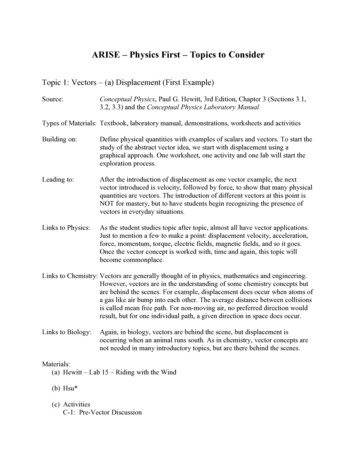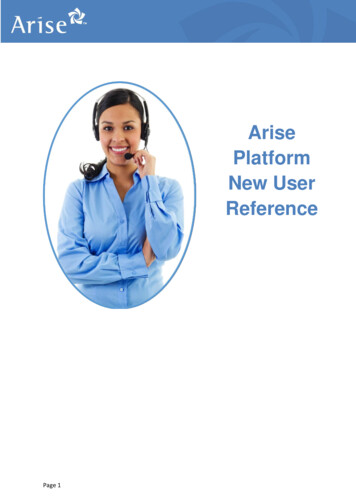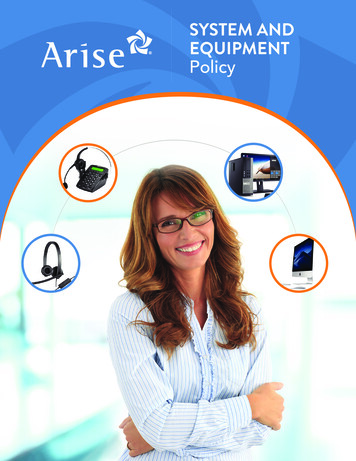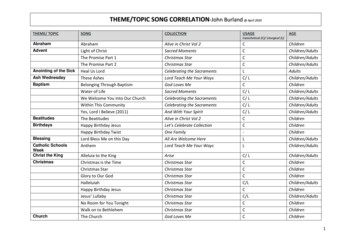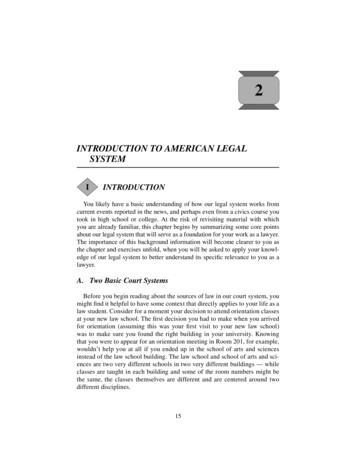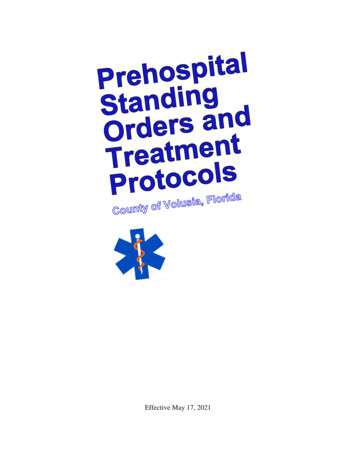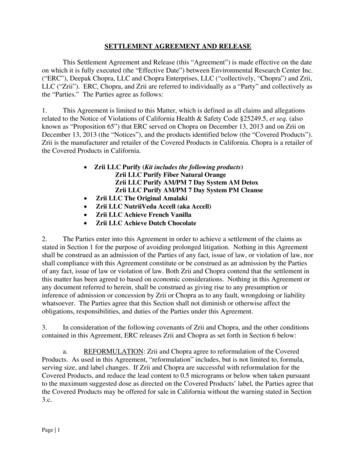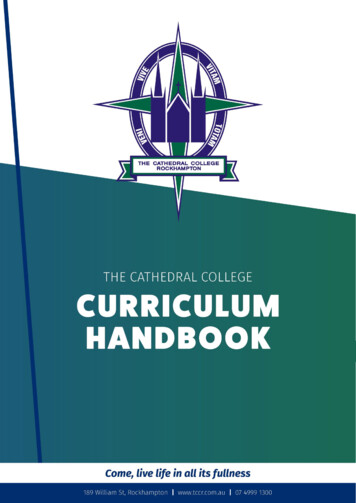
Transcription
2ARISE.ASPIRE.ACHIEVE.
INTRODUCTION4SENIOR EDUCATION PROFILE6Statement of ResultsQueensland Certificate of Education (QCE)Queensland Certificate of Individual Achievement (QCIA)666SENIOR SUBJECTS7Underpinning FactorsVocational Education & Training (VET)Australian Tertiary Admission Rank (ATAR) eligibility899GENERAL SYLLABUSESStructureAssessmentAPPLIED SYLLABUSESStructureAssessmentCOURSES OF STUDYYears 7, 8, 9 and 101010101313131616CAREERS PROGRAM20QCAA SENIOR itiesThe ArtsBusiness, Information & TechnologyFood & Textiles TechnologyHealth & Physical EducationIndustrial Technology & DesignLanguages263243556774931001121211333
INTRODUCTIONThis handbook contains details of thesubjects offered at The Cathedral College(TCC) in each year level. The CathedralCollege Curriculum is formed using theAustralian Curriculum documents and theQueensland Curriculum and AssessmentAuthority (QCAA) Syllabuses.The study of Religious Education, Englishand Mathematics is mandatory across allyear levels.Students entering Year 7 do not have theopportunity to choose electives. Allstudents study a suite of subjects thatprovide them with a broad range ofoptions when choosing electives in futureyear levels. Students in Year 7 study thefollowing subjects for the duration of theyear: Religious EducationEnglishMathematicsScienceHumanitiesHealth and Physical Education.In semester 1, they will also studyBusiness and Digital Technologies,Industrial Technology and Design,Hospitality and Textiles, Visual Arts,Performing Arts and Japanese.4Students entering Year 8 and 9 will study‘Core Subjects’ of Religious Education,English, Mathematics, Science, Humanitiesand Social Science, as well as three (yearduration) elective subjects chosen fromThe Arts, Business and InformationTechnology, Food and Textiles Technology,Industrial Technology and Design,Japanese and Physical Education.Students entering Year 10 will study ‘CoreSubjects’ of Religious Education, English,Mathematics and Science as well as three(year duration) elective subjects chosenfrom The Arts, Business and InformationTechnology, Food and Textiles Technology,Humanities and Social Science, IndustrialTechnology and Design, Japanese andPhysical Education.It is important to note that choosing aparticular elective in Year 8 or 9 does notlock a student into continuing thatelective the following year.Students will need to select theirpreferred subjects using the webpreference system. These preferences willbe blended to formulate an arrangementthat will cater to the interests and needsof most students.
It may be helpful for students to considerthe following when deciding on electivesubjects: In which subjects do I achieve mybest results? What subjects do I enjoy? What subjects would I like to studyas possible courses of study inSenior School? What types of occupations might Ilike to enter after the completion ofmy secondary schooling?create the best learning environment forthemselves and others.The College expects senior schoolstudents to have attained a minimum of aC standard in Year 10 in order to have thefoundation necessary to ensure success inYears 11 and 12. Students who wish toenter Year 11, but whose work has not metthis standard may be required to attendan interview with their parents and theAssistant Principal: Curriculum or CollegePrincipal to discuss their alternatives.Students making the decision toundertake senior studies are making acommitment towards a more independentapproach to learning. With thiscommitment, there needs to be a clearpurpose for continuing with study andschool life. Some students wish to gainknowledge and skills which will lead tofurther study and specialisation at tertiarylevel, while other students will wish togain the skills and competenciesnecessary to lead them directly into fulltime employment or a combination ofonsite training and work.Students undertaking a Tertiary Pathwaymust meet the following prerequisites.The College expects that students wantingto continue in the senior school will havea preparedness to work diligently andproductively in class and at home toGeneral subjects – C in Year 10 GeneralEnglish or Literature.In addition: Japanese – 2 semesters Japanese inYear 9 or 10 Mathematical Methods – C in Year10 MathematicalMethods/Specialist Mathematics Specialist Mathematics – C in Year10 Specialist Mathematics, B in Year10 Mathematical Methods Biology, Psychology – C in Year 10Life Science Chemistry, Physics – C in Year 10Physical Science5
SENIOR EDUCATIONPROFILEStudents in Queensland are issued with a Senior Education Profile (SEP) upon completionof senior studies. This profile may include a: Statement of ResultsQueensland Certificate of Education (QCE)Queensland Certificate of Individual Achievement (QCIA).For more information about the SEP ications/sep.STATEMENT OF RESULTSStudents are issued with a statement of results in the December following the completionof a QCAA-developed course of study.QUEENSLAND CERTIFICATEOF EDUCATION (QCE)Students may be eligible for aQueensland Certificate of Education(QCE) at the end of their seniorschooling. Students who do not meetthe QCE requirements can continue towork towards the certificate postsecondary schooling. The QCAA awardsa QCE in the following July or December,once a student becomes eligible.Learning accounts are closed after nineyears; however, a student may apply tothe QCAA to have the account reopenedand all credit continued.6QUEENSLAND CERTIFICATEOF INDIVIDUALACHIEVEMENT (QCIA)The Queensland Certificate of IndividualAchievement (QCIA) reports the learningachievements of eligible students whocomplete an individual learningprogram. At the end of the senior phaseof learning, eligible students achieve aQCIA. These students have the option ofcontinuing to work towards a QCE postsecondary schooling.
SENIOR SUBJECTSThe QCAA develops four types of senior subject syllabuses — General, Applied, SeniorExternal Examinations and Short Courses. Results in General and Applied subjectscontribute to the award of a QCE and may contribute to an Australian Tertiary AdmissionRank (ATAR) calculation, although no more than one result in an Applied subject can beused in the calculation of a student’s ATAR.Extension subjects are extensions of the related General subjects and are studied eitherconcurrently with, or after, Units 3 and 4 of the General course.Typically, it is expected that most students will complete these courses across Years 11and 12. All subjects build on the P–10 Australian Curriculum.GENERAL SYLLABUSESGeneral subjects are suited to students who are interested in pathways beyond seniorsecondary schooling that lead primarily to tertiary studies and to pathways for vocationaleducation and training and work. General subjects include Extension subjects.APPLIED SYLLABUSESApplied subjects are suited to students who are primarily interested in pathways beyondsenior secondary schooling that lead to vocational education and training or work.7
UNDERPINNING FACTORSAll senior syllabuses are underpinned by:LITERACYThe set of knowledge and skills about language and textsessential for understanding and conveying content.NUMERACYThe knowledge, skills, behaviours and dispositions that students needto use mathematics in a wide range of situations, to recognise andunderstand the role of mathematics in the world, and to develop thedispositions and capacities to use mathematical knowledge and skillspurposefully.GENERAL SYLLABUSESIn addition to literacy and numeracy,General syllabuses are underpinned by:21 century skills – the attributes andskills students need to prepare themfor higher education, work andengagement in a complex and rapidlychanging world. These include criticalthinking, creative thinking,communication, collaboration andteamwork, personal and social skills,and information and communicationtechnologies (ICT) skills.APPLIED SYLLABUSESIn addition to literacy and numeracy,Applied syllabuses are underpinned by: applied learning – theacquisition and application ofknowledge, understanding andskills in real-world or lifelikecontexts community connections — theawareness and understanding oflife beyond school throughauthentic, real-world interactionsby connecting classroomexperience with the worldoutside the classroom core skills for work — the set ofknowledge, understanding andnon-technical skills thatunderpin successful participationin work.st8
VOCATIONAL EDUCATION TRAININGStudents can access VET programs through the school by: third-party arrangements with an external provider who is an RTO undertaking school-based apprenticeships or traineeships.AUSTRALIAN TERIARY ADMISSION RANK(ATAR) ELIGIBILITYThe calculation of an Australian TertiaryAdmission Rank (ATAR) will be based on astudent’s: best five General subject results or best results in a combination offour General subject results plus anApplied subject result or aCertificate III or higher VETqualification.The Queensland Tertiary AdmissionsCentre (QTAC) has responsibility for ATARcalculations.ENGLISH REQUIREMENTEligibility for an ATAR will requiresatisfactory completion of a QCAA Englishsubject.Satisfactory completion will requirestudents to attain a result that isequivalent to a Sound Level ofAchievement in one of five subjects —English, Essential English, Literature andEnglish and Literature Extension.While students must meet this standard tobe eligible to receive an ATAR, it is notmandatory for a student’s English result tobe included in the calculation of theirATAR.9
GENERALSYLLABUSESSTRUCTUREThe syllabus structure consists of a course overview and assessment.GENERAL SYLLABUSES COURSE OVERVIEWGeneral syllabuses are developmentalfour-unit courses of study.their progress in a course of study andcontributes to the award of a QCE.Units 1 and 2 provide foundationallearning, allowing students to experienceall syllabus objectives and beginengaging with the course subject matter.It is intended that Units 1 and 2 arestudied as a pair. Assessment in Units 1and 2 provides students with feedback onStudents should complete Units 1 and 2before starting Units 3 and 4.Units 3 and 4 consolidate studentlearning. Assessment in Units 3 and 4 issummative and student results contributeto the award of a QCE and to ATARcalculations.ASSESSMENTUNITS 1 2 ASSESSMENTSSchools decide the sequence, scope and scale of assessments for Units 1 and 2. Theseassessments should reflect the local context. Teachers determine the assessmentprogram, tasks and marking guides that are used to assess student performance for Units1 and 2.Units 1 and 2 assessment outcomes provide feedback to students on their progress in thecourse of study. Schools should develop at least two but no more than four assessmentsfor Units 1 and 2. At least one assessment must be completed for each unit.10
Schools report satisfactory completion of Units 1 and 2 to the QCAA, and may choose toreport levels of achievement to students and parents/carers using grades, descriptivestatements or other indicators.UNITS 3 4 ASSESSMENTSStudents complete a total of four summative assessments — three internal and oneexternal — that count towards the overall subject result in each General subject.Schools develop three internal assessments for each senior subject to reflect therequirements described in Units 3 and 4 of each General syllabus.The three summative internal assessments need to be endorsed by the QCAA before theyare used in schools. Students’ results in these assessments are externally confirmed byQCAA assessors. These confirmed results from internal assessment are combined with asingle result from an external assessment, which is developed and marked by the QCAA.The external assessment result for a subject contributes to a determined percentage of astudents’ overall subject result. For most subjects this is 25%; for Mathematics and Sciencesubjects it is 50%.INSTRUMENT SPECIFIC MARKING GUIDELINESEach syllabus provides instrument-specific marking guides (ISMGs) for summative internalassessments.The ISMGs describe the characteristics evident in student responses and align with theidentified assessment objectives. Assessment objectives are drawn from the unitobjectives and are contextualised for the requirements of the assessment instrument.Schools cannot change or modify an ISMG for use with summative internal assessment.As part of quality teaching and learning, schools should discuss ISMGs with students tohelp them understand the requirements of an assessment task.11
EXTERNAL ASSESSMENTExternal assessment is summative and adds valuable evidence of achievement to astudent’s profile. External assessment is: common to all schoolsadministered under the same conditions at the same time and on the same daydeveloped and marked by the QCAA according to a commonly applied markingscheme.The external assessment contributes a determined percentage (see specific subject guides— assessment) to the student’s overall subject result and is not privileged over summativeinternal assessment.12
APPLIED SYLLABUSESSTRUCTUREThe syllabus structure consists of a course overview and assessment.APPLIED SYLLABUSES COURSE OVERVIEWApplied syllabuses are developmentalfour-unit courses of study.Units 1 and 2 of the course are designedto allow students to begin theirengagement with the course content, i.e.the knowledge, understanding and skillsof the subject. Course content, learningexperiences and assessment increase incomplexity across the four units asstudents develop greater independenceas learners.Units 3 and 4 consolidate studentlearning. Results from assessment inApplied subjects contribute to the awardof a QCE and results from Units 3 and 4may contribute as a single input to ATARcalculation.A course of study for Applied syllabusesincludes core topics and elective areas forstudy.ASSESSMENTApplied syllabuses use four summative internal assessments from Units 3 and 4 todetermine a student’s exit result.Schools should develop at least two but no more than four internal assessments for Units1 and 2 and these assessments should provide students with opportunities to becomefamiliar with the summative internal assessment techniques to be used for Units 3 and 4.Applied syllabuses do not use external assessment.13
INSTRUMENT-SPECIFIC STANDARDS MATRIXFor each assessment instrument, schools develop an instrument-specific standards matrixby selecting the syllabus standards descriptors relevant to the task and the dimension/sbeing assessed. The matrix is shared with students and used as a tool for makingjudgments about the quality of students’ responses to the instrument. Schools developassessments to allow students to demonstrate the range of standards.ESSENTIAL ENGLISH ESSENTIAL MATHEMATICS –COMMON INTERNAL ASSESSMENTStudents complete a total of four summative internal assessments in Units 3 and 4 thatcount toward their overall subject result. Schools develop three of the summative internalassessments for each senior subject and the other summative assessment is a commoninternal assessment (CIA) developed by the QCAA.The CIA for Essential English and Essential Mathematics is based on the learning describedin Unit 3 of the respective syllabus. The CIA is: developed by the QCAAcommon to all schoolsdelivered to schools by the QCAAadministered flexibly in Unit 3administered under supervised conditionsmarked by the school according to a common marking scheme developed by theQCAA.The CIA is not privileged over the other summative internal assessment.14
SUMMATIVE INTERNAL ASSESSMENT – INSTRUMENTSPECIFIC STANDARDSThe Essential English and Essential Mathematics syllabuses provide instrument-specificstandards for the three summative internal assessments in Units 3 and 4.The instrument-specific standards describe the characteristics evident in studentresponses and align with the identified assessment objectives. Assessment objectives aredrawn from the unit objectives and are contextualised for the requirements of theassessment instrument.15
COURSES OF STUDYCOURSE OF STUDYCOURSE OF STUDYYear Long Subjects:Core Subjects (Year Long): Religious Education Religious Education English English Mathematics Humanities and Social Science Science Mathematics Humanities and Social Science Science Health and Physical EducationSemester Subjects: Business and InformationTechnologyElectives – 3 to be studied (yearduration):The Arts Department Dance Food and Textiles Drama Industrial Technology and Design Music Japanese Performing Arts (Drama, Music) Visual Arts Visual ArtBusiness and Information TechnologyDepartment Economics and Business Digital TechnologiesLanguage Department JapaneseFood and Textiles Department Food Technology FashionIndustrial Technology and DesignDepartment Industrial Technology and DesignPhysical Education Department 16Physical Education
COURSE OF STUDYCore Subjects (Year Long): Religious Education COURSE OF STUDYCompulsory Subjects (Year Long): EnglishReligious Education Humanities and Social ScienceEnglish or Literature MathematicsMathematics ScienceScienceElectives – 3 to be studied (yearduration):The Arts DepartmentElectives – 3 to be studied (yearduration):The Arts Department Dance Dance DramaDrama MusicMedia Arts Music Visual ArtBusiness and Information TechnologyDepartment Economics and BusinessLanguage Department JapaneseFood and Textiles TechnologyDepartment Food and Nutrition Food Technology FashionIndustrial Technology and DesignDepartment Graphics and Design Industrial Technology and DesignPhysical Education Department Physical Education Visual ArtBusiness and Information TechnologyDepartment BusinessCertificate III InformationTechnologyLanguage Department JapaneseHumanities and Social ScienceDepartment History Legal StudiesFood and Textiles TechnologyDepartment Food and Nutrition Hospitality FashionIndustrial Technology and DesignDepartment Design Engineering Skills Furnishing Skills Industrial Graphics SkillsPhysical Education Department Physical Education Health Recreation17
SENIOR APPLIEDSUBJECT(S)VOCATIONAL TRAININGATAR subjectsSenior Applied elective subjectsmay be chosen with or withoutthe year 10 pathway subject,however it is generallyrecommended to have studiedthe pathway subject.Further information is available via the StudentIntranet including the Careers Handbook and courseflyers. These are grouped by area, however Year 10subjects do not form pre-requisites for entry. Alimited number of Certificate courses are availableto students on a General pathway.ReligionStudy of ReligionReligion & EthicsEnglishGeneral EnglishLiteratureEssential EnglishLiteratureGeneral LiteratureYEAR 10 SUBJECTReligionEnglishSENIOR GENERALSUBJECT(S)Essential EnglishSpecialist MathematicsEssential EnglishSpecialist MathematicsMathematics MethodsMathematicsMathematical MethodsMathematics MethodsGeneral MathematicsGeneral MathematicsEssential MathematicsPhysical ScienceEssential MathematicsEssential MathematicsPhysicsCert II Sampling & MeasurementCert II Rural OperationsCert II Rural Operations (Equine)Cert II Animal CareCert II HorticultureChemistryScienceLife ScienceBiologyPsychologyEarth ScienceThe ArtsMedia ArtsFilm, TV & New MediaCert III Screen & MediaCert III Visual ArtsMusicMusicDramaDramaDrama in PracticeVisual ArtVisual ArtVisual Arts in Practice
SENIOR GENERALSUBJECT(S)YEAR 10 SUBJECTBusinessBusinessBusiness &InformationTechnologyCertificate IIIInformation TechnologyLanguagesJapaneseJapaneseHistoryModern HistoryLegal StudiesLegal StudiesFood & NutritionFood & NutritionHumanities &Social ScienceFood & ity PracticesHospitality PracticesFashionFashionEarly Childhood StudiesDesignEngineering SkillsEngineering SkillsFurnishing SkillsFurnishing SkillsIndustrial GraphicsSkillsIndustrial Graphics SkillsPhysical EducationVOCATIONAL TRAININGCert II Workplace Skills (Business)Cert II TourismCert III BusinessCert III Entrepreneurship & New BusinessCert III Accounts AdministrationCert III Information TechnologyCert IV Crime & Justice HospitalityDesignIndustrialTechnology &DesignSENIOR APPLIEDSUBJECT(S)Cert II / Cert III HospitalityCert II Kitchen OperationsCert II Salon AssistantCert II Community Services (Comm Serv)Cert II Community Services (Early Childhood)Cert III Early Childhood StudiesCert III Education SupportCert IV Project Management Practice Cert II Electrotechnology #Cert II Engineering PathwaysCert II Automotive PreparationCert II Aircraft Line MaintenanceCert I ConstructionPhysical EducationRecreationHealthCert III in FitnessCert II Health Support Requires either General English or Literature# Must be achieving at least a B in Year 10 General Mathematics (or C in a higher Mathematics) and undertaking at least General Mathematics in years 11 and 12.19
CAREERS PROGRAM
EMPLOYMENTPATHWAYStudents on an employment pathway candivide their time between school, TAFE, otherprivate providers and workplaces to earnadditional qualifications. In addition toschool studies, these qualifications can satisfythe requirements of the QCE.The Vocational Education and Training inSchools (VETis) programme offers some 12month subsidised Certificate I and CertificateII courses. Each student can only completeone subsidised course. Certificate III coursesentail a cost to the student, unless they arecompleted as part of a School BasedTraineeship, and generally take two years tocomplete.If students elect to undertakecourses/programs or work placement offcampus, all arrangements are to be madethrough the Careers Coordinator, Mrs KarenCopping.The Employment Pathway has been developedto cater for students aiming to equipthemselves with experience, training andqualifications that will ease their entry intothe workforce or TAFE on completion of theirYear 12 studies.CERTIFICATE COURSES(include but not limited to):Courses that go for 18 months and can becommenced in Year 11 are: Cert II in Rural Operations (subsidised) Cert II in Electrotechnology(subsidised) (General Mathsrequirement) Cert II Animal Studies (not subsidised) Cert III in Education Support (checksubsidy) Cert III Early Childhood Education (notsubsidised)Other popular courses that are subsidisedand go for 12 months and can only becommenced in Year 12 are: Cert I Construction Cert II Engineering PathwaysCert II Automotive VocationalPreparation Cert II Health Support ServicesCert II Tourism Cert II Hospitality Cert II Kitchen Operations Cert II Infrastructure and ResourceManagement Cert II Retail CosmeticsMore detailed information is available on theStudent Intranet including the CareersHandbook. Individual course flyers and workexperience documents are available in theCareers Office.21
SCHOOL BASED APPRENTICESHIPS ORTRAINEESHIPS (SATS)22SATS provide students with jobopportunities while increasing theiravailable options at school as well asbeyond Year 12.A comprehensive list of governmentapproved school-based apprenticeshipsand traineeships can be viewed atwww.training.qld.gov.auThis is the classic way to combine workand study so that students can earn whilethey learn. They may work towardsachieving a Certificate II qualification orpartially complete a Certificate IIIqualification while still working towardstheir QCE.ADVANTAGES OF SATS TOSTUDENTS: Achieve an additional nationallyrecognised qualification Paid for on-the-job time in theworkplaceShould a student be offered a SAT, theywill have dual status as a full-time schoolstudent and as a paid employeeundertaking an integrated education,training and employment program. Gain valuable skills learnt on-thejob Receive structed training that iscompetency based Are trained by a Registered TrainingOrganisationEach school-based trainee/apprentice,their parent/guardian and employerenters into a legally binding employeremployee Training Agreement that isregistered with the Department ofEducation and Training. The trainingagreement is usually for a two-yearduration (i.e. through Years 11 and 12), butstudents can complete it in a shorter time.If the traineeship or apprenticeship is notcompleted before the end of the Year 12school year, employers are obligated toemploy the student on a full-time or parttime basis until completion.(Apprenticeships usually have a four-yearduration.) Gain confidence and self-esteem inan adult environment Develop skills and attitudes whichare relevant to the world of work Employability is potentiallyincreased.
FINDING AN EMPLOYERINTERESTED IN HIRING ASATCLOTHING REQUIREDThe College does not actively seek schoolbased apprenticeships and traineeshipson behalf of parents and students.However, the College will provideinformation for parents and students topass on to interested employers detailingthe program and how the processoperates.COSTS OF COURSESStudents must wear specific clothing toTAFE courses dependent on the courserequirement.Costs vary depending on usage ofconsumable materials and text material.The availability of courses and specificcosts are published by the provider.Vacancies are advertised through theemailed Careers Newsletter for which anyeligible student may apply.WORK EXPERIENCEStudents are able to perform a total of 30days of work experience per calendaryear. Students are only able to performwork experience during school holidaysup to and including the last day of theschool year.For students to perform work experience,a Work Experience Agreement must becompleted. Parents and students canmake arrangements for work experiencedirectly with an employer with all partiescompleting and signing the WorkExperience Agreement Form.The agreement provides insurance forthe student whilst in the workplace afterthe Principal has signed the forms. TheCollege must be in possession of theoriginal, before the work experience canbegin.Information is provided for the employer,parents and students to peruse theliability/insurance conditions andexclusions. The College advises parents tohave adequate private medical cover asthe College insurance only coverspermanent injury or death. Parents ofstudents in Year 11 and 12 who needassistance in contacting potential workexperience employers should contact theCareers Coordinator.23
QCAA SENIORSYLLABUSESThe following subjects will be offered at the selection process. Subjects are contingent onan appropriate number of students choosing the subject from 2019 through to 2020.RELIGIONTHE ARTSGeneral Study of ReligionGeneral Drama Film, TV and New Media Visual ArtApplied Religion & EthicsApplied Drama in Practice Visual Arts in PracticeENGLISHGeneral English Literature English & Literature Extension(Units 3 & 4)Applied Essential EnglishBUSINESS & INFORMATIONTECHNOLOGYGeneral BusinessApplied TourismMATHEMATICSGeneral General Mathematics Mathematical Methods Specialist MathematicsApplied Essential Mathematics24FOOD & TEXTILESTECHNOLOGYGeneral Food & NutritionApplied Early Childhood Studies Hospitality Practices
HEALTH & PHYSICALEDUCATIONGeneral Physical EducationCertificate Course Certificate III FitnessHUMANITIESGeneral Legal Studies Modern HistoryLANGUAGESGeneral JapaneseSCIENCEGeneral Biology Chemistry Physics PsychologyINDUSTRIAL TECHNOLOGY& DESIGNGeneral DesignApplied Engineering Skills Furnishing Skills Industrial Graphics Skills25
RELIGION26
INTRODUCTIONThe Cathedral College is proud of its Catholic identity. The teachings of Jesus Christ are thefoundation for the school’s core values of compassion, gratitude and respect, and informevery aspect of learning, teaching and being a part of the College community. Animportant part of each student’s personal development is exploring their spirituality anddeveloping a set of values that will ensure they are productive and well-rounded citizens.Religious Education, while underpinned by the teachings of the Catholic Church, alsomakes opportunities to explore, compare and discuss other world religions andphilosophies. It is vital that students have religious and spiritual literacy so they canembrace difference and make informed choices about their own faith journey.YEAR 7 RELIGIOUS EDUCATIONYear Focus: The ways in which believers live their faithSemester 1Semester 2Unit 1 Topic: Sacred TextsUnit 3 Topic: ChurchUnit 1 Assessment: Icon DesignUnit 3 Assessment: Prayer InvestigationUnit 2 Topic: BeliefsUnit 4 Topic: Christian LifeUnit 2 Assessment: TED Talk PresentationUnit 4 Assessment: Orientation PosterYEAR 8 RELIGIOUS EDUCATIONYear Focus: The relationship between God and God’s peopleSemester 1Semester 2Unit 1 Topic: Sacred TextsUnit 3 Topic: ChurchUnit 1 Assessment: Storyboard/PodcastUnit 3 Assessment: ReportUnit 2 Topic: BeliefsUnit 4 Topic: Christian LifeUnit 2 Assessment: Scripture AnalysisUnit 4 Assessment: InfographicYEAR 9 RELIGIOUS EDUCATIONSemester 1Unit 1 Topic: Sacred TextsUnit 1 Assessment: Scripture EvaluationUnit 2 Topic: BeliefsUnit 2 Assessment: TED TalkSemester 2Unit 3 Topic: ChurchUnit 3 Assessment: ReportUnit 4 Topic: Christian LifeUnit 4 Assessment: ExaminationYEAR 10 RELIGIOUS EDUCATIONSemester 1Unit 1 Topic: Sacred TextsUnit 1 Assessment: Evaluation of ArtworkUnit 2 Topic: BeliefsUnit 2 Assessment: ExaminationSemester 2Unit 3 Topic: ChurchUnit 3 Assessment: ReportUnit 4 Topic: Christian LifeUnit 4 Assessment: Examination27
GeneralSTUDY OF RELIGIONGeneral Senior SubjectStudy of Religion Study of Religioninvestigates religious traditions and howreligion has influenced, and continues toinfluence, people’s lives. Students becomeaware of their own religious beliefs, thereligious beliefs of others, and how peopleholding such beliefs are able to co-exist ina pluralist society.Students study the five major worldreligions of Judaism, Christianity, Islam,Hinduism and Buddhism; and AustralianAboriginal spiritualities and Torres Strait
studied as a pair. Assessment in Units 1 and 2 provides students with feedback on their progress in a course of study and contributes to the award of a QCE. Students should complete Units 1 and 2 before starting Units 3 and 4. Units 3 and 4 consolidate student learning. Assessment in Units 3 and 4 is summative and student results contribute


